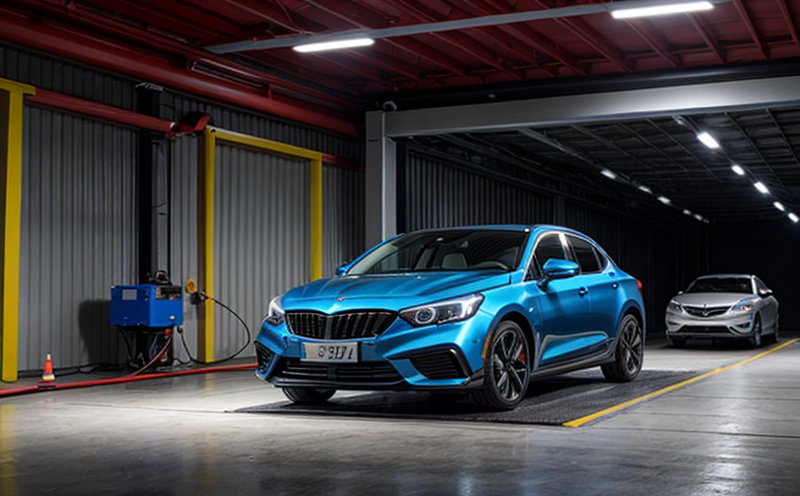Driveline Clunk Noise Testing
The driveline clunk noise testing is a critical aspect of automotive NVH (Noise, Vibration, and Harshness) evaluation. This specialized test ensures that the drivetrain components function harmoniously without producing excessive noise or vibration. Driveline clunks are one of the most common complaints in passenger vehicles, and addressing them early in the development process can significantly enhance customer satisfaction and reduce warranty claims.
The primary focus is on detecting and diagnosing clunk noises caused by misalignment or wear in the driveline components such as axles, hubs, bearings, and CV joints. By simulating real-world driving conditions, this test helps engineers identify potential issues that could lead to noise complaints from end-users. The testing process involves a series of maneuvers designed to stress the driveline under various operating conditions.
During the test, the vehicle is driven through a controlled environment where technicians can capture audio and video data using high-fidelity equipment. This setup allows for precise measurement and analysis of any unusual sounds. Once identified, these noises are categorized based on their frequency, amplitude, and duration to provide insights into possible root causes.
The testing apparatus typically includes specialized rigs that simulate different types of road surfaces and driving scenarios. These include straight-line acceleration, braking maneuvers, turns at various speeds, and even off-road conditions if necessary. The goal is to ensure the driveline can handle all foreseeable stresses without producing unacceptable levels of noise.
Accurate and repeatable results are crucial for this test. Therefore, it follows strict guidelines defined by international standards such as ISO 6948 and SAE J1342. Compliance with these standards ensures that the testing methodology is consistent across different manufacturers and laboratories worldwide. This consistency helps in maintaining quality control throughout the supply chain.
Driveline clunk noise testing also plays a vital role in ensuring regulatory compliance. Many regions have stringent requirements regarding vehicle emissions, including noise levels. By conducting thorough tests during the development phase, automakers can avoid costly recalls and potential legal penalties associated with non-compliance.
Benefits
- Enhanced Product Quality: Identifies clunk noises early in the design process to ensure a smoother riding experience for consumers.
- Cost Savings: Reduces warranty costs and potential recalls by addressing issues before mass production begins.
- Better Customer Satisfaction: Ensures that vehicles meet or exceed customer expectations regarding comfort and quietness.
The driveline clunk noise testing provides significant advantages to manufacturers, including enhanced product quality, cost savings through reduced warranty claims, and improved customer satisfaction. These benefits contribute directly to the overall success of any automotive brand by fostering trust and loyalty among consumers.
Environmental and Sustainability Contributions
- Reduced Noise Pollution: By minimizing clunk noises in vehicles, this testing contributes positively towards reducing noise pollution levels in urban areas.
- Eco-Friendly Manufacturing Processes: Ensuring quieter drivelines can lead to more efficient manufacturing processes which consume less energy and resources.
The benefits extend beyond just the product itself; they also impact environmental sustainability. For instance, quieter vehicles contribute to lower noise pollution in densely populated cities. Additionally, optimizing the design for reduced clunk noises could potentially streamline production lines, leading to more efficient use of materials and less waste generation.
Use Cases and Application Examples
The driveline clunk noise testing is widely used across various stages of vehicle development. It serves as an essential tool for identifying potential issues during design validation, prototype evaluation, and final production verification.
- Design Validation: In this phase, the test helps designers understand how different configurations affect sound levels in the driveline.
- Prototype Evaluation: Engineers use this testing to refine prototypes by making necessary adjustments based on feedback from early tests.
- Final Production Verification: Before releasing a new model into mass production, manufacturers conduct comprehensive clunk noise tests to ensure consistency across all units produced.
In addition to these core applications, the data collected during driveline clunk noise testing can also inform other aspects of vehicle development such as suspension tuning or interior trim selection. For example, if certain components consistently produce high-frequency clunks under specific driving conditions, this information might influence decisions about seat materials or dashboards that could help absorb vibrations.
Real-world application examples include luxury brands like Mercedes-Benz and BMW who incorporate advanced NVH testing into their R&D processes to maintain industry-leading standards. Similarly, emerging markets such as China are increasingly adopting stringent noise regulations which drive demand for more accurate clunk noise tests at all stages of production.





